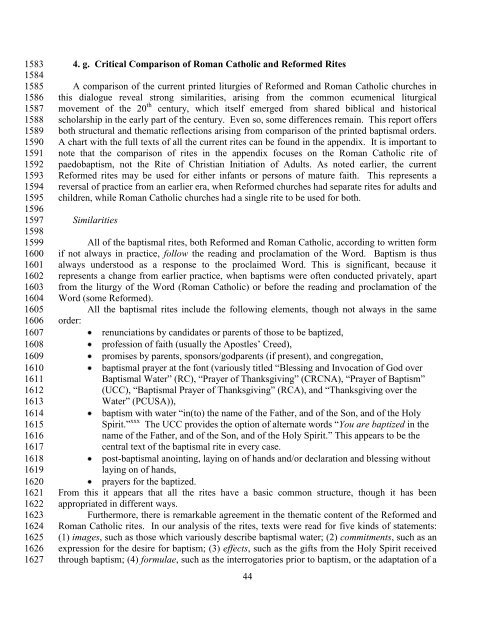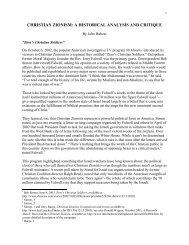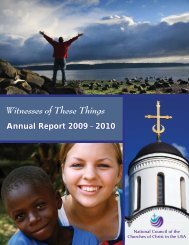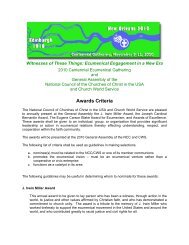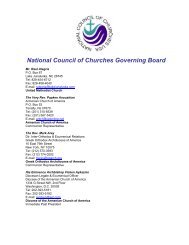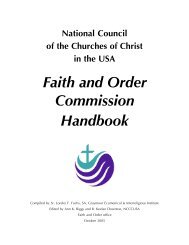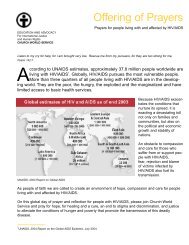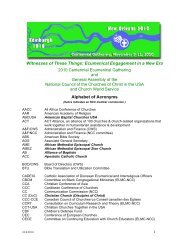Common Agreement on Mutual Recognition of Baptism - National ...
Common Agreement on Mutual Recognition of Baptism - National ...
Common Agreement on Mutual Recognition of Baptism - National ...
Create successful ePaper yourself
Turn your PDF publications into a flip-book with our unique Google optimized e-Paper software.
1583<br />
1584<br />
1585<br />
1586<br />
1587<br />
1588<br />
1589<br />
1590<br />
1591<br />
1592<br />
1593<br />
1594<br />
1595<br />
1596<br />
1597<br />
1598<br />
1599<br />
1600<br />
1601<br />
1602<br />
1603<br />
1604<br />
1605<br />
1606<br />
1607<br />
1608<br />
1609<br />
1610<br />
1611<br />
1612<br />
1613<br />
1614<br />
1615<br />
1616<br />
1617<br />
1618<br />
1619<br />
1620<br />
1621<br />
1622<br />
1623<br />
1624<br />
1625<br />
1626<br />
1627<br />
4. g. Critical Comparis<strong>on</strong> <strong>of</strong> Roman Catholic and Reformed Rites<br />
A comparis<strong>on</strong> <strong>of</strong> the current printed liturgies <strong>of</strong> Reformed and Roman Catholic churches in<br />
this dialogue reveal str<strong>on</strong>g similarities, arising from the comm<strong>on</strong> ecumenical liturgical<br />
movement <strong>of</strong> the 20 th century, which itself emerged from shared biblical and historical<br />
scholarship in the early part <strong>of</strong> the century. Even so, some differences remain. This report <strong>of</strong>fers<br />
both structural and thematic reflecti<strong>on</strong>s arising from comparis<strong>on</strong> <strong>of</strong> the printed baptismal orders.<br />
A chart with the full texts <strong>of</strong> all the current rites can be found in the appendix. It is important to<br />
note that the comparis<strong>on</strong> <strong>of</strong> rites in the appendix focuses <strong>on</strong> the Roman Catholic rite <strong>of</strong><br />
paedobaptism, not the Rite <strong>of</strong> Christian Initiati<strong>on</strong> <strong>of</strong> Adults. As noted earlier, the current<br />
Reformed rites may be used for either infants or pers<strong>on</strong>s <strong>of</strong> mature faith. This represents a<br />
reversal <strong>of</strong> practice from an earlier era, when Reformed churches had separate rites for adults and<br />
children, while Roman Catholic churches had a single rite to be used for both.<br />
Similarities<br />
All <strong>of</strong> the baptismal rites, both Reformed and Roman Catholic, according to written form<br />
if not always in practice, follow the reading and proclamati<strong>on</strong> <strong>of</strong> the Word. <strong>Baptism</strong> is thus<br />
always understood as a resp<strong>on</strong>se to the proclaimed Word. This is significant, because it<br />
represents a change from earlier practice, when baptisms were <strong>of</strong>ten c<strong>on</strong>ducted privately, apart<br />
from the liturgy <strong>of</strong> the Word (Roman Catholic) or before the reading and proclamati<strong>on</strong> <strong>of</strong> the<br />
Word (some Reformed).<br />
All the baptismal rites include the following elements, though not always in the same<br />
order:<br />
renunciati<strong>on</strong>s by candidates or parents <strong>of</strong> those to be baptized,<br />
pr<strong>of</strong>essi<strong>on</strong> <strong>of</strong> faith (usually the Apostles‘ Creed),<br />
promises by parents, sp<strong>on</strong>sors/godparents (if present), and c<strong>on</strong>gregati<strong>on</strong>,<br />
baptismal prayer at the f<strong>on</strong>t (variously titled ―Blessing and Invocati<strong>on</strong> <strong>of</strong> God over<br />
<strong>Baptism</strong>al Water‖ (RC), ―Prayer <strong>of</strong> Thanksgiving‖ (CRCNA), ―Prayer <strong>of</strong> <strong>Baptism</strong>‖<br />
(UCC), ―<strong>Baptism</strong>al Prayer <strong>of</strong> Thanksgiving‖ (RCA), and ―Thanksgiving over the<br />
Water‖ (PCUSA)),<br />
baptism with water ―in(to) the name <strong>of</strong> the Father, and <strong>of</strong> the S<strong>on</strong>, and <strong>of</strong> the Holy<br />
Spirit.‖ xxx The UCC provides the opti<strong>on</strong> <strong>of</strong> alternate words ―You are baptized in the<br />
name <strong>of</strong> the Father, and <strong>of</strong> the S<strong>on</strong>, and <strong>of</strong> the Holy Spirit.‖ This appears to be the<br />
central text <strong>of</strong> the baptismal rite in every case.<br />
post-baptismal anointing, laying <strong>on</strong> <strong>of</strong> hands and/or declarati<strong>on</strong> and blessing without<br />
laying <strong>on</strong> <strong>of</strong> hands,<br />
prayers for the baptized.<br />
From this it appears that all the rites have a basic comm<strong>on</strong> structure, though it has been<br />
appropriated in different ways.<br />
Furthermore, there is remarkable agreement in the thematic c<strong>on</strong>tent <strong>of</strong> the Reformed and<br />
Roman Catholic rites. In our analysis <strong>of</strong> the rites, texts were read for five kinds <strong>of</strong> statements:<br />
(1) images, such as those which variously describe baptismal water; (2) commitments, such as an<br />
expressi<strong>on</strong> for the desire for baptism; (3) effects, such as the gifts from the Holy Spirit received<br />
through baptism; (4) formulae, such as the interrogatories prior to baptism, or the adaptati<strong>on</strong> <strong>of</strong> a<br />
44


